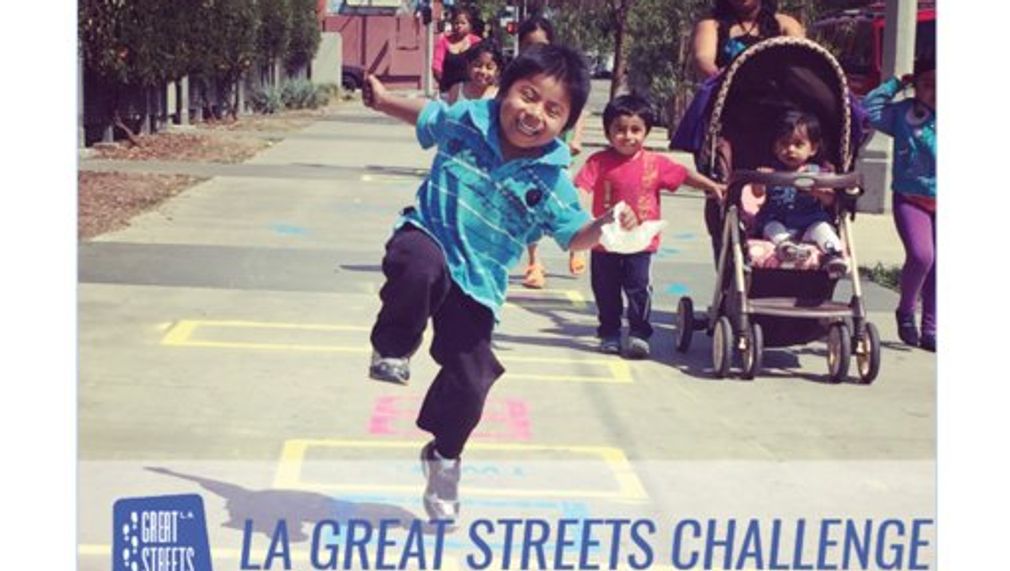The Great Streets Challenge: Making Streets Playful Public Places
The Great Streets Challenge will temporarily transform five main streets into vibrant, healthy, playful public spaces. Community based organizations will design and lead projects through a comprehensive outreach process that will culminate in a physical demonstration of an innovative street design. This process fundamentally disrupts traditional planning and capital development by empowering local communities to re-imagine their front yards – city streets – and then demand permanent change.

In what areas of Los Angeles will you be directly working?
City of Los Angeles
How do you plan to use these resources to make change?
Conduct research
Engage residents and stakeholders
Expand a pilot or a program
Mobilize for systems change
Advocate with policymakers and leaders
Physically transform streets into safer, accessible public spaces and educate community members on interventions to improve safety of and access to public spaces
How will your proposal improve the following PLAY metrics?
Access to open space and park facilities
Per capita crime rates
Percentage of residents that feel safe in their neighborhoods
Residents within 1⁄4 mile of a park (Dream Metric)
Number of residents with easy access to a “vibrant” park (Dream Metric)
Number of parks with intergenerational play opportunities (Dream Metric)
Number (and quality) of informal spaces for play (Dream Metric)
Describe in greater detail how you will make LA the best place to PLAY.
The Great Streets Challenge will improve Los Angeles’ access to public spaces by temporarily transforming five streets into playful public spaces.
Los Angeles has over 7,500 miles of streets in the city. It is physically our largest public asset. For decades, we have used our streets for largely one purpose: to facilitate the movement of vehicles. Consider that only half of Angelenos live within walking distance of a park, but that almost all Angelenos have access to an arterial corridor in their neighborhood. Why can’t our streets serve as parks? Imagine, instead of building streets for cars, we turned some streets into places where people could play, gather and actively enjoy their neighborhood. We believe that our streets are the answer to our lack of convenient access to open space.
The goal of our campaign will be to educate community members on the long-term possibilities of streets as public spaces, while also building low-cost improvements that can transform the street in the short-term. We will use the principles of tactical urbanism to demonstrate how simple, low-cost improvements can transform a street into a place for play, exercise, and comfort.
Our campaign has four objectives:
Engaging community members that have traditionally been excluded from the planning process: We will increase our outreach impact by partnering with groups embedded in the community through traditional and non-traditional efforts. Bringing demonstrations onto the street will improve the number and diversity of those involved.
Using a data-driven approach to help understand the needs of communities: Our process will be focused on measurable outcomes. Building off current street benchmarking activities, we will use our community partnerships to collect information on how streets are currently being used and how we can make streets safer, more enjoyable public spaces.
Temporarily building improvements in the street: During a weekend, communities could demonstrate anything from protected bike lanes for safer and more fun travel, to bus stops that have swings built into them. This has two benefits: educating community members about the benefits of streets as public spaces, while immediately improving access to open space.
Using community engagement, data collection and a temporary build, we will inform investments that the city can pursue for permanent projects.
Please explain how you will evaluate your work.
Our goal is to increase access to healthy, safe, playful public spaces. Our success will be in how many people participate in designing spaces in their communities, how many people learn about the benefits of streets as public spaces, and how many people enjoy their time in these spaces.
Success will also be reflected in how many short-term projects we can transform into permanent improvements. We must be able to use our communities’ recommendations for permanent infrastructure. Year over year, we will measure our success by collecting data related to:
• Increased Economic Activity
• Improved Access and Mobility
• Enhanced Neighborhood Character
• Greater Community Engagement
• Improved Environmental Resilience
• Safer and More Secure Communities
• Improved Health Outcomes
Please see attached spreadsheet for a full list of metrics we will collect to measure success.
How can the LA2050 community and other stakeholders help your proposal succeed
Money (financial capital)
Volunteers/staff (human capital)
Publicity/awareness (social capital)
Education/training
Community outreach
Network/relationship support